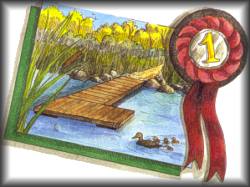The Dock Page
When it comes to disruption of the shoreline and littoral zone, a large solid dock often ranks high on the list. It can disrupt shore line currents, remove habitat, and it is generally not good for the lake or river.
The bed of a lake or river is public land (you don't own it) and falls under the management control of Parks Canada (the Rideau) or the Ontario Ministry of Natural Resources (other areas). You will require their permission to install any type of dock.
There are good environmentally sound alternatives to a conventional dock. These alternatives have financial as well as environmental advantages. In addition, they make the permitting process much easier.
Floating Docks
 These are the least disruptive type of dock. They don't touch the bed of the lake or river and they don't obstruct currents, fish or plant communities. A well designed floating dock can be solid and stable. They generally cost about the same as a fixed dock but are much less susceptible to ice damage and require less yearly maintenance. They have an advantage for the boater in that they float up and down with changing water levels. No more finding your dock underwater or three feet above your boat. These are the least disruptive type of dock. They don't touch the bed of the lake or river and they don't obstruct currents, fish or plant communities. A well designed floating dock can be solid and stable. They generally cost about the same as a fixed dock but are much less susceptible to ice damage and require less yearly maintenance. They have an advantage for the boater in that they float up and down with changing water levels. No more finding your dock underwater or three feet above your boat.

Cantilever and Post Supported Docks
These are the next best thing to a floating dock. They are usually slightly cheaper than a floating dock and may be a good alternative for someone who just wants a small dock. As long as they have a solid anchoring point on the shore, and are raised in the winter, they can last for many years.
Dock Dogma
- docks should intrude as little as possible into the ribbon of life.
- docks should not obstruct the bed of the lake.
- docks should occupy less than about 10 percent of lot frontage.
- dock plans should be checked early with agency staff for easy approval.
If you are planning to build a dock or boathouse on the waters of the Rideau Canal (including Dog Lake, Adams Lake and part of the Tay River) then see:
For more information view the Ministry of Natural Resources fact sheet on Fish Habitat, Docks & Boathouses
Note: Drawings on this page taken from "On the Waterfront" published by the Rideau Valley Conservation Authority
|